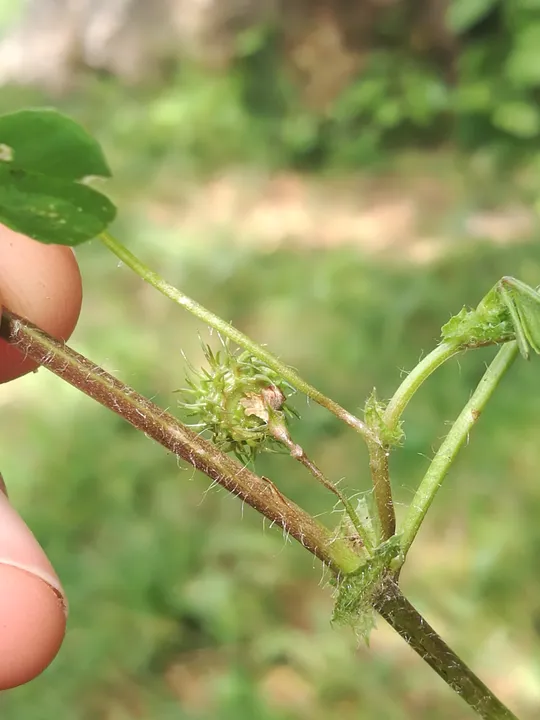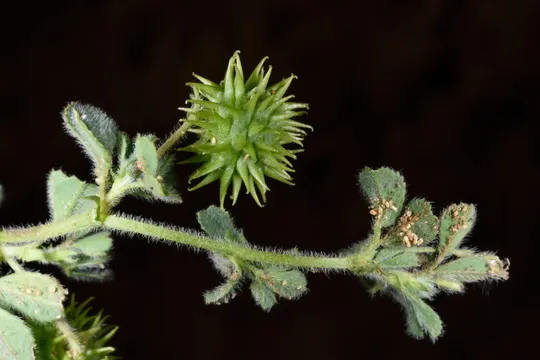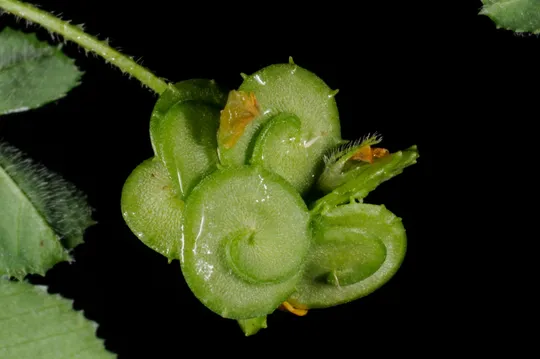Hairy Canarayflower, Hairy Canary Clover
Dorycnium hirsutum

Dorycnium hirsutum is a highly branched dwarf shrub, 30-60 cm high, with a woody base. Leaves are trifoliate and very hairy. The two stipules are very similar to the three leaflets and giving the leaf the appearance of having five stalkless leaflets. Flowers are arranged in spherical inflorescences on a long stalk that is longer than the leaf from whose axil it grows. There are four hairy leaflets at the base of the inflorescence. Flowers are large, 1-1.5 cm, ivory white with a purple keel. The pod is short, slightly longer than the calyx.
An ornamental plant in Europe and in California, a pasture plant in Australia.
Before its extinction, it was also very rare. Recorded in Flora Palaestina and plant guides from the Upper Galilee, Mount Carmel and Samaria. Has not been found in the field since the 1960s. In 1963, Schmida found a single individual flowering near the Forester's House in the upper Yagur Stream on Mount Carmel. The Hebrew University Herbarium has only two specimens, one from Mount Carmel and the other from En HaShofet in the Ramot Menashe region (T. Kushnir, 1940, this herbarium sheet was the basis of the Flora Palaestina record of Dorycnium growing in Samaria). There are no herbarium sheets from the Galilee or from Samaria. The species was not found in the rare plant survey conducted in northern Israel.
In shady humid woodlands.
The genus includes four species whose main distribution is in the Mediterranean Basin. The genus is closely related to the Lotos genus, which was the basis of its Hebrew name. Dorycnium hirsutum can be distinguished from D. rectum by its large flowers, up to twice as large as the D. hirsutum flowers and by its hairy leaves. Dorycnium hirsutum grows in shady, humid woodlands unlike D. rectum that grows on stream and water body banks.
• The plant has always been very rare, and its extinction may be due to its small population sizes, that create pollination problems, demographic accidents and increased probability of extinction due to environmental changes.
• Its global distribution is relatively broad, but no information is available regarding the danger of global extinction.
The species was known with certainty only from shady, damp woodlands on steep northern slopes on the Carmel. Therefore is of paramount importance to locate populations of Dorycnium hirsutum on the Carmel and to naturalize it in this habitat.
Grows in all the northern Mediterranean Basin countries from Spain in the west to Turkey and Lebanon in the east; in North Africa it is known only from Algeria and there is some penetration into the Euro-Siberian area on the Atlantic Coast. The plant is cultured in Australia and North America.
The species was probably found in the past exclusively on the Carmel, and the records from the Galilee, Samaria or Ramot Menashe are probably erroneous. This is the only case in Israel of natural extinction cannot be attributed to development or to human interference.
Current Occupancy Map
| 1000 squre meter pixel | 5000 squre meter pixel | 10000 squre meter pixel | |
|---|---|---|---|
| number of observations | 0 | 0 | 0 |
| in total pixels | 0 | 0 | 0 |
| Family | Fabaceae |
| Classification | On the endangered species list |
| Ecosystem | Mediterranean |
| Chorotype | Northern Mediterranean |
| Conservation Site | Yagur Stream on the Carmel |
| Rarity |
1
6
6
|
|---|---|
| Vulnerability |
0
0
4
|
| Attractiveness |
0
0
4
|
| Endemism |
0
0
4
|
| Red number |
1
-1.0
10
|
| Peripherality | N |
| IUCN category | DD EW EX LC CR EN VU NT |
| Threat Definition according to the red book | Extinct |
 Based on:
Based on:






